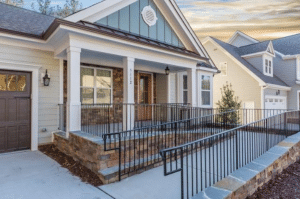
Esther Cromwell discovered her passion for senior care after helping an elderly, widowed neighbor. She built on that interest to found her first family-care home in 2005. Today, she serves as the co-founder and president of Avendelle Assisted Living, which is headquartered in Raleigh, North Carolina.
In an interview with Senior Living Executive, Cromwell shared her insights on the current state of assisted living, including the most prominent issues and opportunities for the industry, and explained how Avendelle is carving out its niche in the field.
SLE: What are the biggest challenges that the assisted living industry is facing today?
Avendelle: The assisted living industry faces several pressing challenges that impact its ability to provide high-quality care.
- Workforce shortages and retention issues remain a top concern, as recruiting and keeping skilled caregivers is difficult due to burnout, low wages and high turnover rates.
- At the same time, rising operational costs, including inflation-driven increases in labor, medical supplies, utilities, and food, make financial sustainability a challenge for many facilities.
- Additionally, shifting consumer preferences have led more seniors to seek personalized, home-like care models or age in place, forcing providers to rethink their service offerings.
- The industry also grapples with regulatory and compliance pressures, requiring constant adaptation to evolving state and federal mandates, which adds complexity and costs to operations.
- Affordability remains a major concern, as the cost of assisted living continues to rise, leaving many middle-class families struggling to afford quality care, especially when Medicaid and insurance coverage fall short.
- Finally, technology integration presents both opportunities and challenges, as facilities work to implement digital solutions like telehealth and smart monitoring systems while managing the associated costs and staff training.
To overcome these challenges, providers must focus on innovation, workforce investment, regulatory adaptation and financial strategies to ensure long-term sustainability and enhanced resident care.
SLE: What has driven your labor strategy and how has it worked?
Avendelle: Avendelle Assisted Living has addressed workforce shortages by creating a supportive and engaging work environment that prioritizes both caregiver well-being and high-quality resident care.
- By maintaining low resident-to-caregiver ratios, Avendelle ensures that staff members are not overwhelmed, allowing them to provide more personalized and meaningful care while reducing burnout.
- Additionally, the company fosters a home-like atmosphere in its small, residential-style homes, which not only enhances the experience for residents but also improves job satisfaction for caregivers, making their work more fulfilling and less stressful than in larger institutional settings.
- Avendelle also emphasizes individualized attention and relationship-building, giving caregivers the opportunity to form deeper connections with residents, which leads to greater job satisfaction and higher retention rates.
This strategy is driven by Avendelle’s commitment to both resident well-being and staff happiness, creating a sustainable model that has successfully mitigated workforce shortages while ensuring consistent, high-quality care.
 SLE: How have you contended with rising operational costs?
SLE: How have you contended with rising operational costs?
Avendelle: Avendelle Assisted Living has effectively addressed rising operational costs through strategic initiatives aimed at enhancing efficiency and financial transparency. By implementing an all-inclusive pricing model, Avendelle offers clear and predictable pricing, simplifying financial planning for families and reducing administrative complexities associated with managing multiple service fees. Additionally, the company has been an early adopter of technologies such as telehealth services and smart home systems, which improve operational efficiency, enhance resident safety and potentially lower costs related to in-person medical consultations and emergency responses.
Furthermore, Avendelle’s focus on small, home-like settings allows for more intimate and cost-effective care environments compared to larger facilities, leading to savings in staffing and maintenance expenses. These strategies are driven by a commitment to providing high-quality, personalized care while maintaining financial sustainability. The results include enhanced financial clarity for families, improved operational efficiencies, and the ability to deliver personalized care in cost-effective settings.
SLE: How have you chosen to navigate today’s regulatory demands?
Avenelle: We have implemented a comprehensive compliance program that includes regular internal audits, clear policies and procedures, accurate documentation and a culture of compliance. We also participate in industry associations to stay updated on regulatory changes. This proactive approach ensures adherence to evolving regulations and demonstrates a commitment to continuous improvement.
SLE: In today’s climate, there is an expectation for personalized care – what does that look like at Avendelle?
Avendelle: Avendelle Assisted Living has proactively addressed evolving expectations for personalized care by implementing a unique approach that emphasizes individualized attention and a homely environment. By operating small, residential-style homes with an average of six residents per home, Avendelle fosters a family-like atmosphere, allowing caregivers to provide one-on-one care tailored to each resident’s needs and preferences.
This model is driven by a commitment to treat each resident with dignity, compassion and care, ensuring their voices are heard and honored. The effectiveness of this strategy is evident in the high levels of resident satisfaction and the nurturing community that Avendelle has cultivated, setting a new standard in personalized senior care.
SLE: What role does innovation and adaptability play in assisted living today?
Avendelle: Innovation and adaptability are critical in today’s assisted living environment due to the rapidly changing needs and expectations of seniors, increasing regulatory requirements, and ongoing workforce and financial challenges.
- As more seniors seek personalized and home-like care models, facilities must adapt by offering individualized services, smaller residential settings, and enhanced lifestyle options.
- Technology integration, including telehealth, smart monitoring systems, and AI-driven care solutions, is also transforming the industry, improving efficiency, safety, and the overall resident experience.
- Additionally, workforce shortages require new staffing models, training programs, and retention strategies to ensure high-quality care.
- Rising operational costs and affordability concerns further emphasize the need for innovative financial models and cost-effective service delivery.
Assisted living providers that embrace change, invest in new solutions, and remain flexible in their approach will be best positioned to thrive in an increasingly complex and competitive landscape.
SLE: Where does the field of assisted living most need to get better?
Avendelle: The assisted living industry has several areas that need improvement to better meet the needs of an aging population.
- Workforce development remains a top priority, as staffing shortages and caregiver burnout continue to impact the quality of care. Providers must focus on better wages, benefits and career growth opportunities to attract and retain skilled workers.
- Affordability and accessibility also need to be addressed, as rising costs make assisted living unaffordable for many middle-class families, with limited Medicaid and insurance support.
- Additionally, regulatory consistency and efficiency could be improved to ensure high standards of care while reducing the administrative burden on providers.
- Personalization and technology integration are other key areas for growth, as seniors increasingly expect more tailored services, smart health monitoring and a greater emphasis on independence.
By focusing on these improvements, the industry can enhance the quality, sustainability and accessibility of care for the growing senior population.
SLE: Looking ahead, are there trends that you think will be particularly important in shaping the industry’s future? What are the keys to adapting to – and perhaps embracing – those trends?
Avendelle: Several key trends will shape the future of the assisted living industry, requiring providers to adapt and innovate.
- Personalized and home-like care models are becoming more popular as seniors seek smaller, more intimate settings that offer individualized attention. To embrace this shift, facilities must focus on customized care plans, flexible service options and a resident-centered approach.
- Technology integration will also be critical, with telehealth, smart home monitoring and AI-driven solutions improving efficiency, safety and the overall quality of care. Providers must invest in digital tools and staff training to stay competitive.
- Additionally, workforce challenges will persist, requiring better recruitment and retention strategies, competitive wages and professional development opportunities for caregivers.
- Affordability and financial sustainability will be another major focus, as providers must explore new funding models, partnerships and cost-effective service delivery methods to keep care accessible.
Successfully adapting to these trends will require a commitment to innovation, operational flexibility and a deep understanding of evolving senior care needs.
The Value of Assisted Living in America
The expected workforce crisis in long-term-care necessitates bolder action than we’ve seen up to now. Expanding seniors access to assisted living communities and developing the workforce to meet future demands will ease fiscal pressure on vital public health programs and improve the quality of life for our rapidly aging population. The numbers do not lie. Our nation is aging and aging rapidly. The time to act is now. Download your copy of The Value of Assisted Living for America today!
 SLE: How have you contended with rising operational costs?
SLE: How have you contended with rising operational costs?
